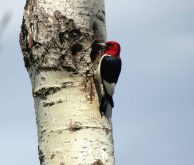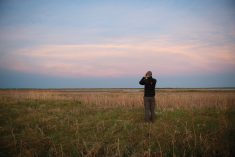Nestled on the south edge of Lake Manitoba’s Delta Marsh, where it meets Portage Creek, there sits a pastoral slice of paradise. The tract covers 31 acres of riparian habitat, wetland, forest and meadow, and is home to hundreds of species of wild animals and birds — plus two humans, Cal and Elaine Cuthbert.
For Cal Cuthbert, the property is his childhood home and a legacy that has been in his family for four generations. It was his backyard and his playground, a setting that helped shape him, and an area he has come to love.
Now, that pristine bit of landscape, along with his family’s legacy, will be protected in perpetuity, and that suits him just fine.
Why it matters: The Nature Conservancy of Canada (NCC) is a private, non-profit land conservation organization with a mandate to protect wildlife habitat. That sometimes takes the form of conservation agreements, which partner the organization with like-minded landowners.
The Cuthberts recently signed a conservation agreement with the Nature Conservancy of Canada (NCC), which restricts uses for that land in an effort to protect the natural habitats.
“Conservation agreements are voluntary legal agreements between the landowner and NCC that set mutually agreed-upon restrictions on certain activities on the land,” Cary Hamel, the NCC’s director of conservation in Manitoba, said. “It’s a tool in the toolbox of land conservation.”
While the landowner retains ownership of the property, restrictions get filed on the title and stay with the land. Should land then be sold or pass to the next generation, the new landowners would also be bound by the agreement.
“Essentially, they have altered the value of the property a little bit by putting restrictions on it,” Hamel said.
That change in value is what the Cuthberts donated to the NCC.
The nature of a conservancy agreement can vary from case to case, depending on what is being conserved, according to the NCC. Hamel says that most conservation agreements protect what the organization considers ‘working’ landscapes, so biodiversity is maintained in collaboration with ongoing sustainable agriculture or ranching.

“Cattle grazing or haying and all those types of things are typically quite compatible with biodiversity outcomes,” he said. “Prairie grasslands get along really well with livestock. They used to be under regular disturbance from bison, locusts and fire. Having some kind of disturbance is essential to maintaining them.”
The Cuthberts, however, have opted to keep their land outside of livestock or forage production. Their agreement stipulates that the parcel, although including some land that could be used for haying or grazing, will not be put to those uses.
Birth of a passion
Cal Cuthbert claimed his love of nature as the reasoning behind the NCC deal.
“I think growing up at the south end of Lake Manitoba with the literally world-renowned Delta Marsh as my backyard, it was really hard not to have an interest in nature,” he said. “It was just a wonderful, amazing area to grow up in.”
His surroundings fed into his interest as a waterfowl hunter, given the wealth of wetland in his immediate area, and later, after trading in his gun for a set of binoculars, an avid enthusiasm for birding. To date, he has documented over 200 species of birds on his property, several of which are endangered.
“I keep lists of birds. In fact, some people think I keep lists of lists, which I probably do,” he joked.
That ardour for the natural world followed him into adulthood, and into his new life after marriage. Finding a job with Ducks Unlimited Canada, he made his living working in the Brandon and Minnedosa field offices of that organization.
It was also the reason he gained ownership of the 31-acre parcel of land. His parents, reasoning that his love of nature would be a good fit for that area, set the wheels in motion for him to inherit it, while his brother would end up farming the neighbouring property.
At the time of inheritance, Cal and Elaine Cuthbert were living in Brandon, and they treated the property on the other side of the province like a cottage.
“Elaine and I really enjoyed coming out here,” Cal Cuthbert reminisced. “We would come out on weekends and cut grass or, if there was a tree falling over, I’d get the chainsaw and cut it up, or tear down derelict buildings — just general maintenance as people who have an acreage know all about.”
By 2016, however, the couple had retired and began thinking about relocating permanently to the parcel.
The pros quickly outweighed the cons in the couple’s mind. The Cuthberts commissioned a ready-to-move home out of Winnipeg, upped stakes from western Manitoba, and have since lived on the property.
The years following the move were filled with Cal Cuthbert’s activities of choice: birdwatching, carving out hiking trails and drinking in the landscape. “We enjoyed it so much,” he enthused.
As time passed and notions of his own mortality began to sneak into his thoughts, he began to think of what might happen to this property in the future. Conversations in the Cuthbert house turned to preserving the land, eventually turning to an agreement with the NCC, which the couple felt would protect the land exactly as they intended.
“I’d hate to see anything happen to this property: the trails, the wetlands, the cattails, the oak, the deer, the different species of birds, just the beauty of it. When we go, I just want this place to stay as is for future generations to enjoy,” Cal Cuthbert said.
While conservation agreements have got a less than enthusiastic reaction from many farmers, who argue the remaining land use does not offset the loss in value or cost to keep it, the Cuthberts say that, for their purposes, the deal is not onerous.
The land, after all, is already valued by its owners for wildlife rather than agriculture.
Likewise, the couple says, the agreement involves little interference from the NCC.
“One of their reps will come out once a year just to do a walk in the trails and do a quick check on the property and just see that it is up to standards as of the time that we signed the agreement,” Cal Cuthbert said. “In fact, I wish they’d pop out more than they do. Once a year is fine, we’ll have coffee and a piece of saskatoon pie. It’s all good.”
As for the change to the land title, “it’s simply a caveat,” he said. “It’s registered on our title. I own the land, and pay taxes on it. It’s just that the caveat the Nature Conservancy of Canada has placed on it has stipulations that they, myself and Elaine have agreed to.
“Most importantly, the bush can never be pushed down and the wetland can’t be compromised in a way that would negatively impact water quality or its function as a wetland.”
The meadow, likewise, he is growing back into a natural habitat that will be preserved.
But for Cal Cuthbert, one of the most important aspects of the agreement is the perpetuity clause.
“It is a long time, which is exactly what a perpetuity conservation easement is all about,” he said. “I don’t want something for five years. I don’t want something for 10 years. I don’t want something for 20 years… Some of these trees are in excess of 200 years old. These trees were around when bison were still coming through this area!”
Walking with Cal Cuthbert through the now-protected land, his binoculars are glued to his face — presumably to find that elusive 221st bird species in his forest. He knows every tree: the ancient oaks, the ash, the remnants of his great-grandfather’s orchard. He registers mild annoyance with local bucks, who rub their antlers on saplings, cutting their young lives short. He’s even named one of the grouse that will frequently come to greet him as he walks his paths. He calls the territorial bird Grumpy Gilmour.
“Walking through some of these trails here and it’s… well, I guess spiritual may be a little overreach for some people, but it is a very peaceful feeling,” he said.

















